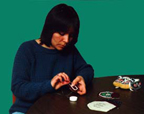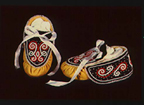Contemporary
“I have been making this style of traditional beadwork for about 10 years. I had seen pictures of the old collars, peaked caps, and pouches that were made here years ago and I had a feeling that it was my calling to start doing this style of beadwork again. I really enjoy making the traditional beadwork because I’m always learning something new. I’ve always felt since the first pouch I made that I’m just the hands and that the designs, their meanings, and the knowledge to create the piece comes from somewhere else. A lot of times I won’t know how to do something and my hands will just do it for me, and I’ll think, ‘Oh so that’s how you do that.’ Sometimes I imagine these old beadworkers spirits hovering around while I work, guiding my hands and whispering, ‘do it this way,’ and ‘put that design over there.’ A lot of our traditions have slipped away or have totally been lost. But I really believe that it’s all still out there for us – if we just ask respectfully and then know how to listen.
 |
 |
| Jennifer Sapiel Neptune Penobscot, Indian Island |
Old-style Baby Moccasins. Jennifer Sapiel Neptune 1997-1998 |
What I would like people to remember as they look at the older pieces is that real people spent countless hours making these pieces. Making anything with beads that tiny is a major investment of time and energy, and just like us they had families to care for and homes to tend to. I think it’s really unfortunate that most of these pieces became labeled as tourist art, because I think that they were much more than that.
Many times it seems that Native American art and artifacts are viewed as just objects, but really you are looking at a piece of someone’s heart and soul. The objects and designs had real meaning to people. The design might have a very different meaning to the beadworker than to the person viewing it. For example, the generally held and accepted view in academia is that the floral designs are European in origin and were ‘copied’ by Native Americans to make their beadwork more appealing to Victorian era tourists. However, as a beadworker and a Native American, my perspective is completely different. I see medicine plants in the designs, and it’s obvious to me that people were beading designs of plants that were highly valued to themselves, their families, their tribe.
When I look at the floral designs I see plants that ease childbirth, break fevers, soothe coughs and colds, take away pain, heal cuts, burns and bruises, and maintain general health. For thousands of years these plants were used for healing by the tribes in this area. A hundred years ago plants were the main source of medicine for Natives as well as non-natives. With the knowledge and importance of these plants in our culture beadworkers needed to look no further than their own backyards for their own floral designs. A hundred years later these same plants are still in our backyards, are still being used for healing and are still being used to inspire our beadwork designs.”
—Jennifer Sapiel Neptune
